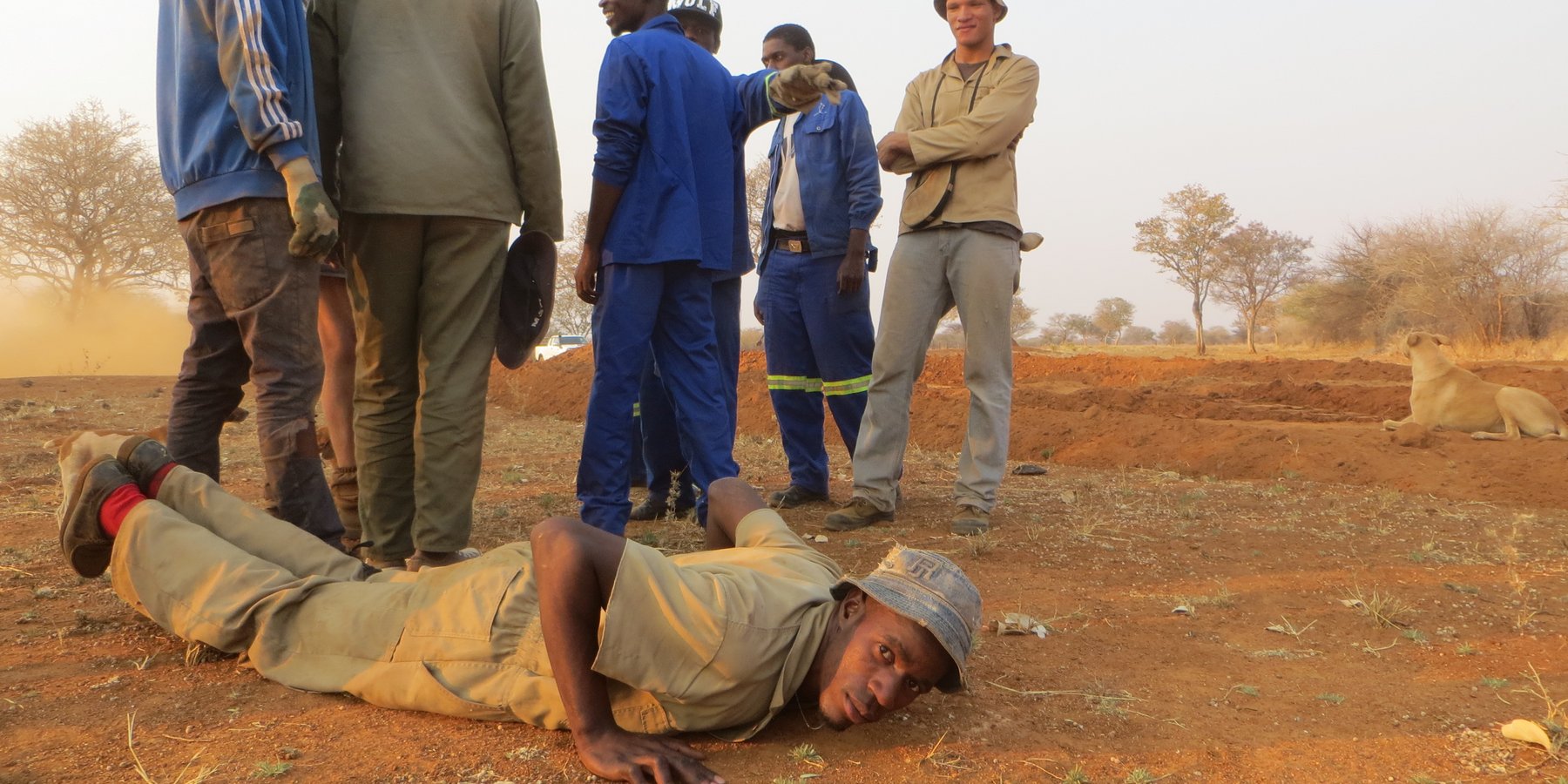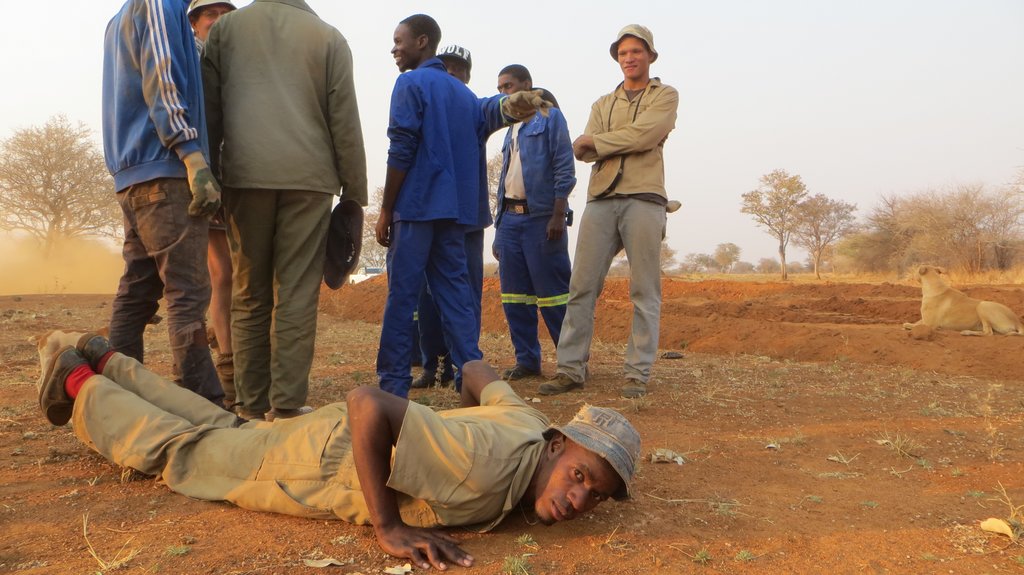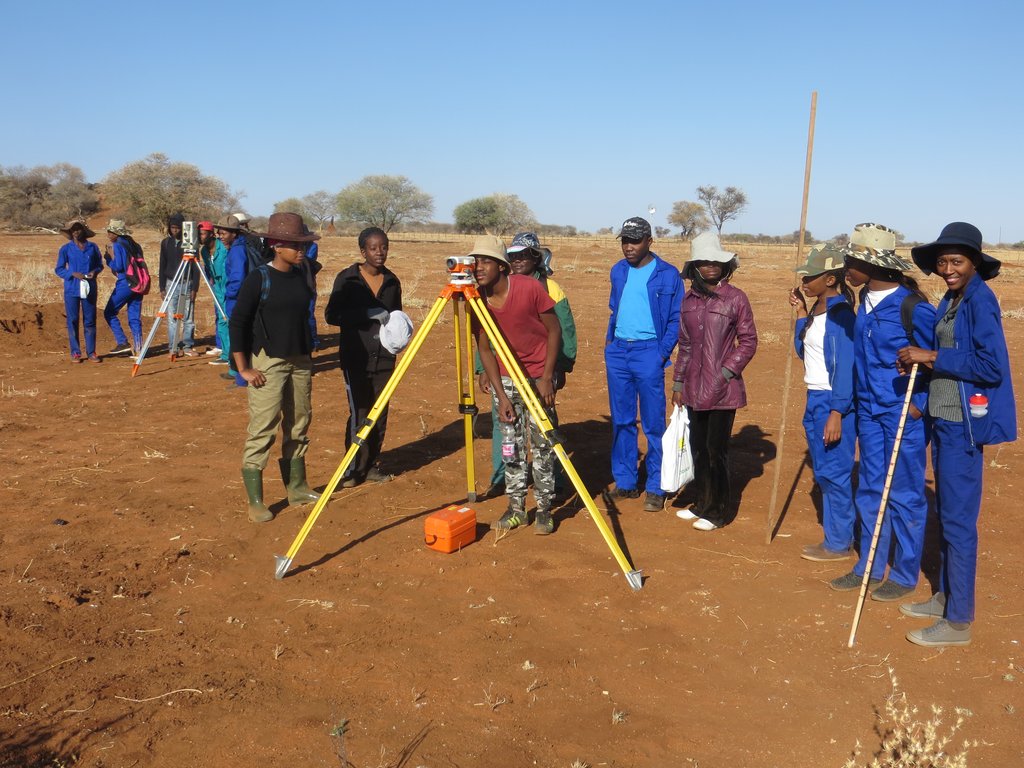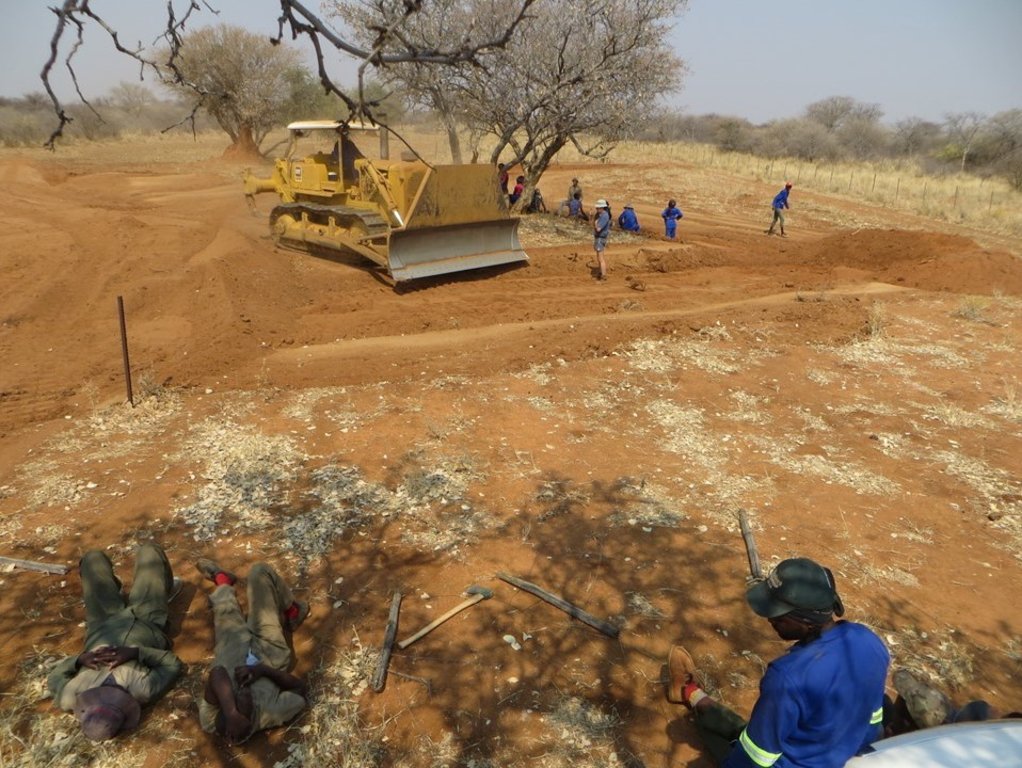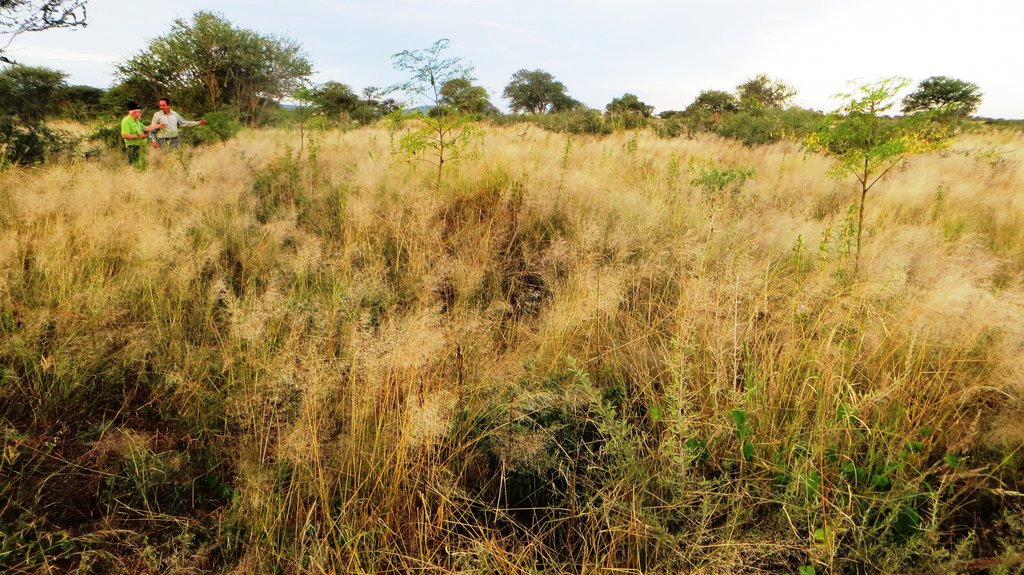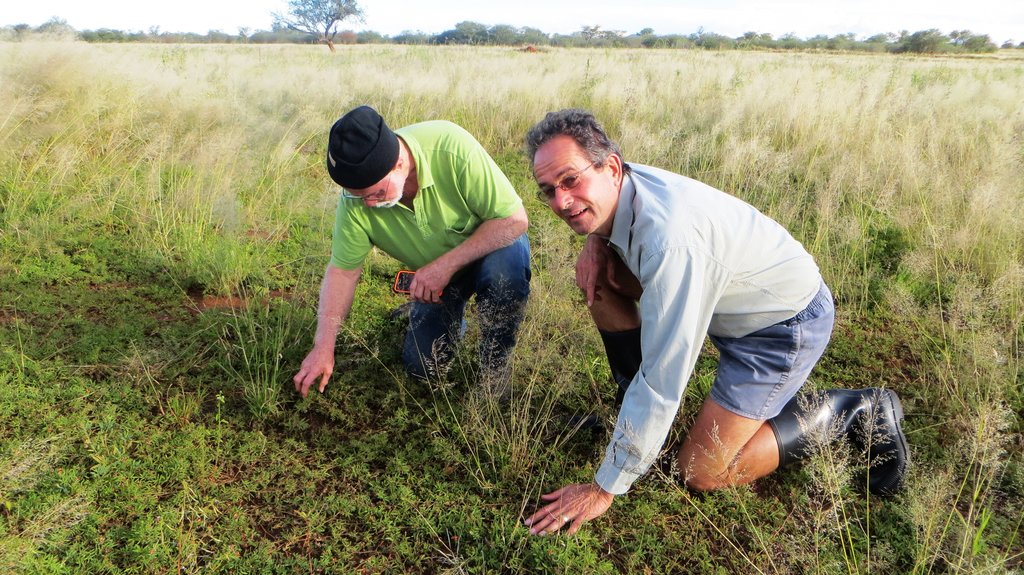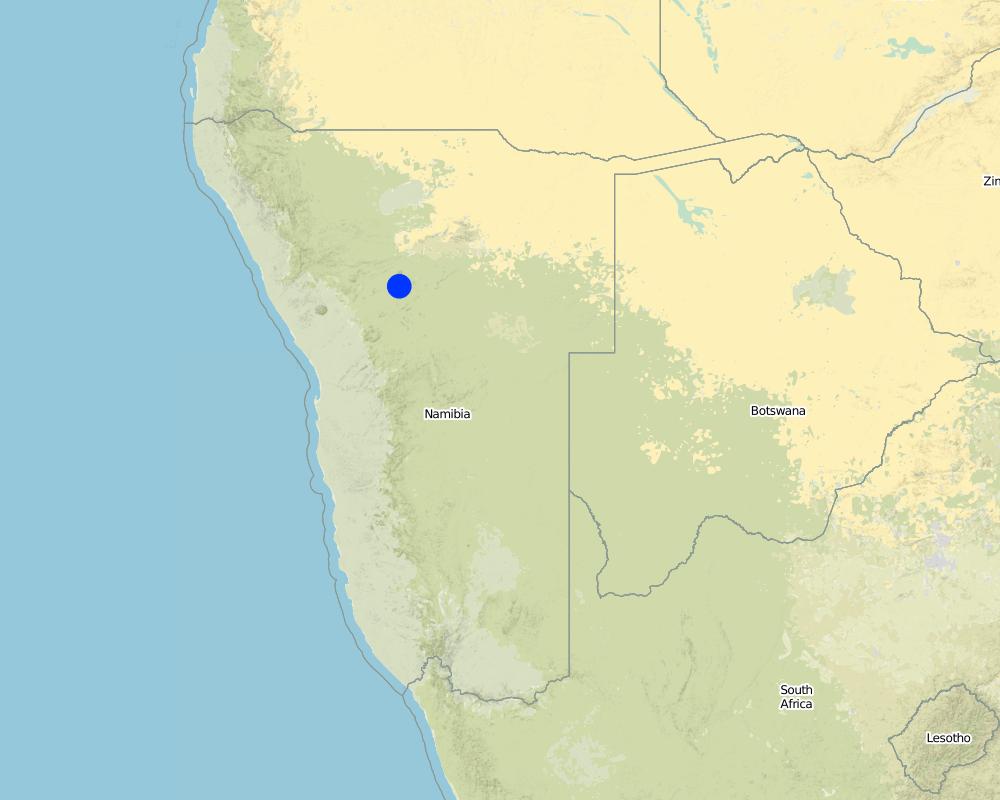Arrangements to convert degraded rangeland into fruitful landscape [Namibia]
- Creation:
- Update:
- Compiler: Ibo Zimmermann
- Editor: –
- Reviewer: Rima Mekdaschi Studer
Otjikunino
approaches_2847 - Namibia
View sections
Expand all Collapse all1. General information
1.2 Contact details of resource persons and institutions involved in the assessment and documentation of the Approach
land user:
Kahl Uwe
+264 67 290004 / +264811486666
uwe2008@iway.na
Farm Middelplaats
P.O. Box 213 Otjiwarongo
Namibia
SLM specialist:
Pringle Hugh
hpringle1@bigpond.com
Ecosystem Management Understanding
P.O. Box 8522 Alice Springs NT 0871
Australia
Name of project which facilitated the documentation/ evaluation of the Approach (if relevant)
Southern African Science Service Centre for climate change and Adaptive Land management (SASSCAL)Name of the institution(s) which facilitated the documentation/ evaluation of the Approach (if relevant)
Namibia University of Science and Technology ( NUST) - NamibiaName of the institution(s) which facilitated the documentation/ evaluation of the Approach (if relevant)
German Federal Ministry of Education and Research (BMBF) - Germany1.3 Conditions regarding the use of data documented through WOCAT
When were the data compiled (in the field)?
2017
The compiler and key resource person(s) accept the conditions regarding the use of data documented through WOCAT:
Ja
1.4 Reference(s) to Questionnaire(s) on SLM Technologies
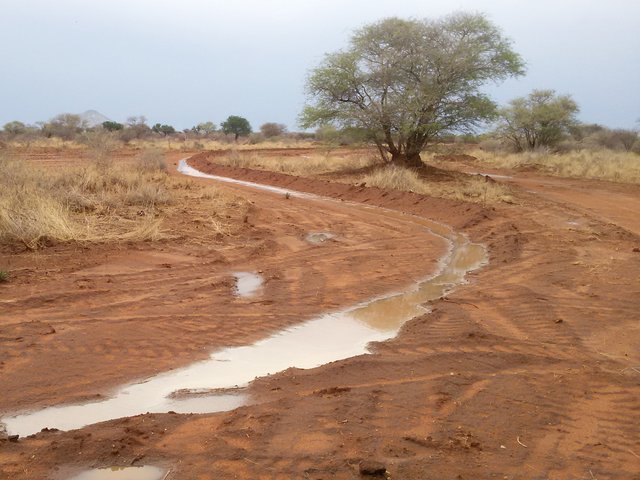
Infiltration ditches and ponding banks [Namibia]
Construction of contour ditches and ponding banks/ bunds to trap rainwater for infiltration. Improved growth of plants and replenishment of groundwater is promoted, while safely discharging excess water to avoid erosion. Integrated with other technologies that treat the root causes of rangeland degradation - rather than a stand-alone technology.
- Compiler: Ibo Zimmermann
2. Description of the SLM Approach
2.1 Short description of the Approach
Making arrangements between a commercial farmer and agriculture students to raise the productivity of rangeland - through managing runoff to grow multipurpose trees and bushes.
2.2 Detailed description of the Approach
Detailed description of the Approach:
The approach was to form linkages between the Namibia University of Science and Technology (NUST) and a large-scale commercial farmer to improve the efficiency of rainwater on rangeland. This was technically achieved by reducing runoff while increasing infiltration and transpiration. The objective is to share knowledge and experiences gained by the farmer to grow valuable woody plants, grass and herbs, which students could then apply elsewhere. Since the approach is applied in parts of the rangeland that experience high runoff, one of the first stages of implementation is to address the root causes of erosion - if not already in place. This could be through sound grazing management that provides sufficient rest for grasses to replenish food reserves after grazing. In turn this maintains grasses in a nutritious, leafy stage of growth. If infrastructure such as a farm road or dam has concentrated runoff water, then this too needs to be addressed, by spreading the runoff over gentle and wide portions of the landscape. Thereafter, an appropriate site is identified based largely on the local knowledge of the farmer. A variety of circumstances are taken into account to select the appropriate site, such as one that (a) receives considerable runoff rainwater, (b) has sufficiently deep soil for earthmoving and (c) proximity to where the farmer lives to enable more intensive management than that required by normal rangeland. Contour lines and gentle gradients are then laid out, whether by dumpy or laser level as was done by NUST students, or generated by analysis of aerial photographs taken by drone. Earthmoving equipment is then used for digging ditches and raising bunds or ponding banks to harvest rainwater. For smaller areas or where labour is plentiful, the contour ditches can be dug by hand – as was done by students on the campus of Katutura Youth Enterprise Centre (KAYEC) in Windhoek. After enough rain had fallen to sufficiently moisten the soil below contour ditches, tree seedlings were planted. This was done by farm workers and students at both the Middelplaats farm and KAYEC. Trees included large canopy species, shorter thornless types for “chop and drop” mulching and those that produce fruits or edible leaves. While the banks become crucial fertile patches in this arid landscape, they also act as broad barriers to sheet flow, slowing it down and increasing infiltration rates locally. Thus degraded “leaky landscapes” turn into “sponge landscapes” and restore deeper and more persistent soil moisture. The greatest cost, for earthmoving, was borne by the farmer. NUST paid for its students to visit the farm, sometimes supported by the landscape literacy project of SASSCAL funded by the German BMBF, which also brought in a technical advisor.
2.3 Photos of the Approach
2.4 Videos of the Approach
Comments, short description:
Only a short section in the film from 18m07s to 19m15s
https://www.youtube.com/watch?v=6C4V_Cib8ts
Date:
08/04/2015
Location:
Farm Middelplaats and KAYEC campus, both in Namibia
Name of videographer:
Andrew Botelle
2.5 Country/ region/ locations where the Approach has been applied
Country:
Namibia
Region/ State/ Province:
Otjozondjupa
Further specification of location:
Farm Middelplaats
Comments:
The point is at the homestead of Farm Middelplaats
Map
×2.6 Dates of initiation and termination of the Approach
Indicate year of initiation:
2014
Year of termination (if Approach is no longer applied):
1900
2.7 Type of Approach
- recent local initiative/ innovative
2.8 Main aims/ objectives of the Approach
To make arrangements between a university and a farmer to improve rainwater efficiency in rangeland for growing valuable trees, grass and herbs for multiple use.
2.9 Conditions enabling or hindering implementation of the Technology/ Technologies applied under the Approach
social/ cultural/ religious norms and values
- hindering
Viewed with scepticism by some conventional farmers, who do not believe that rainwater harvesting can be cost-effective in rangeland.
availability/ access to financial resources and services
- hindering
May be difficult to convince lenders of repayment potential.
institutional setting
- enabling
The Namibia University of Science and Technology appreciates the valuable experience that its students can gain through this approach.
collaboration/ coordination of actors
- enabling
A trustworthy relationship has developed.
legal framework (land tenure, land and water use rights)
- enabling
Freehold land is being used.
land governance (decision-making, implementation and enforcement)
- enabling
Under control of willing farmer at Middelplaats.
- hindering
Engineers dug a trench at KAYEC to drain water off the land, thus defeating the purpose of rainwater harvesting ditches constructed by students.
knowledge about SLM, access to technical support
- enabling
There is willingness to gain further experience through experimentation
markets (to purchase inputs, sell products) and prices
- enabling
There is demand for the diverse products from fruitful landscapes.
workload, availability of manpower
- enabling
Farmer has access to earthmoving equipment with good operators.
- hindering
A road grader is not big enough for the job. The ideal machine is a CAT 14 bulldozer.
3. Participation and roles of stakeholders involved
3.1 Stakeholders involved in the Approach and their roles
- local land users/ local communities
Farmer.
Implements the activities.
- SLM specialists/ agricultural advisers
Two staff of the Namibia University of Science and Technology (NUST).
Advise on technicalities.
- researchers
Students of the Namibia University of Science and Technology (NUST).
Monitoring effectiveness of the technology.
- teachers/ school children/ students
Classes of students of the Namibia University of Science and Technology (NUST).
Mark out contour lines where the technology is to be implemented.
- international organization
Southern African Science Service Centre for climate change and Adaptive Land management.
Funds an international advisor and students to participate in the project.
3.2 Involvement of local land users/ local communities in the different phases of the Approach
| Involvement of local land users/ local communities | Specify who was involved and describe activities | |
|---|---|---|
| initiation/ motivation | interactive | Farmer requested advice from NUST and discussions took place. |
| planning | interactive | A plan was drawn up through collaboration between farmer and advisers. |
| implementation | interactive | NUST students marked out contour lines. Farmer organised construction of infrastructure, planting of trees and their irrigation. |
| monitoring/ evaluation | interactive | Farmer keeps records of activities and students track tree survival and growth. |
3.3 Flow chart (if available)
Description:
Linkages between farmer and university to convert rangeland into fruitful landscape.
Author:
Ibo Zimmermann
3.4 Decision-making on the selection of SLM Technology/ Technologies
Specify who decided on the selection of the Technology/ Technologies to be implemented:
- all relevant actors, as part of a participatory approach
Explain:
The farmer of Middelplaats asked for advice from NUST, discussions were held, a plan was jointly drafted, followed by implementation by both farmer and students and advisers of NUST. Informal reviews are held annually where key issues are discussed and the project is “tweaked”.
Specify on what basis decisions were made:
- evaluation of well-documented SLM knowledge (evidence-based decision-making)
- research findings
- personal experience and opinions (undocumented)
- External experts' visits and suggestions
4. Technical support, capacity building, and knowledge management
4.1 Capacity building/ training
Was training provided to land users/ other stakeholders?
Ja
Specify who was trained:
- land users
- field staff/ advisers
- Students
Form of training:
- on-the-job
- courses
Subjects covered:
Theory of rangeland science, water cycling and landscape literacy. Practical observational skills and use of dumpy and laser levels.
Comments:
The farmer was trained in planning banks with a laser level, as were two staff in marking contour lines. The machine operator was trained in earthworks.
4.2 Advisory service
Do land users have access to an advisory service?
Ja
Specify whether advisory service is provided:
- on land users' fields
Describe/ comments:
The farmer could potentially offer an advisory service to other farmers based on experiences gained.
4.3 Institution strengthening (organizational development)
Have institutions been established or strengthened through the Approach?
- no
4.4 Monitoring and evaluation
Is monitoring and evaluation part of the Approach?
Ja
If yes, is this documentation intended to be used for monitoring and evaluation?
Nee
4.5 Research
Was research part of the Approach?
Ja
Specify topics:
- economics / marketing
- ecology
Give further details and indicate who did the research:
Small research projects are carried out by students of the Namibia University of Science and Technology to fulfil requirements for their course work.
5. Financing and external material support
5.1 Annual budget for the SLM component of the Approach
If precise annual budget is not known, indicate range:
- 2,000-10,000
Comments (e.g. main sources of funding/ major donors):
Mostly paid for by farmer, for operation of earthmoving equipment, which will not need to be repeated annually. A small amount for fieldwork by students and advisors paid from SASSCAL research funds.
5.2 Financial/ material support provided to land users
Did land users receive financial/ material support for implementing the Technology/ Technologies?
Nee
5.3 Subsidies for specific inputs (including labour)
- other
| Other (specify) | To which extent | Specify subsidies |
|---|---|---|
| Marking of contour lines | Done as part of student training |
If labour by land users was a substantial input, was it:
- paid in cash
Comments:
Fully paid by farmer at Middelplaats, but provided at KAYEC by students as part of their training.
5.4 Credit
Was credit provided under the Approach for SLM activities?
Nee
5.5 Other incentives or instruments
Were other incentives or instruments used to promote implementation of SLM Technologies?
Ja
If yes, specify:
Advice was provided on implementation, and contour lines were marked out by students.
6. Impact analysis and concluding statements
6.1 Impacts of the Approach
Did the Approach empower local land users, improve stakeholder participation?
- No
- Yes, little
- Yes, moderately
- Yes, greatly
Only one farmer and his workers have been deeply involved. Others have been briefly exposed to the project.
Did the Approach enable evidence-based decision-making?
- No
- Yes, little
- Yes, moderately
- Yes, greatly
Records of tree survival determined the need for initial irrigation.
Did the Approach help land users to implement and maintain SLM Technologies?
- No
- Yes, little
- Yes, moderately
- Yes, greatly
By advising the farmer at different stages of implementation.
Did the Approach improve coordination and cost-effective implementation of SLM?
- No
- Yes, little
- Yes, moderately
- Yes, greatly
At a key meeting it was agreed that grazing pressure from horses and wildlife was holding back the project.
Did the Approach improve knowledge and capacities of land users to implement SLM?
- No
- Yes, little
- Yes, moderately
- Yes, greatly
Experience gained by farmer and workers, and exposure to some other farmers.
Did the Approach improve knowledge and capacities of other stakeholders?
- No
- Yes, little
- Yes, moderately
- Yes, greatly
NUST students gained experience and understanding.
Did the Approach improve gender equality and empower women and girls?
- No
- Yes, little
- Yes, moderately
- Yes, greatly
Students who participated included many females.
Did the Approach lead to improved food security/ improved nutrition?
- No
- Yes, little
- Yes, moderately
- Yes, greatly
Growth of fruit/edible leaf/fodder trees, such as Moringa oleifera, and improved forage.
Did the Approach lead to improved access to water and sanitation?
- No
- Yes, little
- Yes, moderately
- Yes, greatly
Improved infiltration replenishes groundwater, which is used by both people and animals for drinking, and lush forage reduces drinking by livestock.
Did the Approach improve the capacity of the land users to adapt to climate changes/ extremes and mitigate climate related disasters?
- No
- Yes, little
- Yes, moderately
- Yes, greatly
Improved rainwater -use efficiency on small part of farm.
Did the Approach lead to employment, income opportunities?
- No
- Yes, little
- Yes, moderately
- Yes, greatly
Saleable products such as Moringa leaves.
6.2 Main motivation of land users to implement SLM
- increased production
Grass and trees grow better where rainwater infiltrated
- increased profit(ability), improved cost-benefit-ratio
More of better quality forage
- reduced land degradation
Better plant cover and soil biology
- reduced risk of disasters
Improved buffering against drought
- environmental consciousness
By students and farm workers are exposed to the approach
- enhanced SLM knowledge and skills
By students and farm workers are exposed to the approach
- aesthetic improvement
Less bare ground and a more diverse landscape with reduction in extremes of temperature
6.3 Sustainability of Approach activities
Can the land users sustain what has been implemented through the Approach (without external support)?
- yes
If yes, describe how:
The farmer will continue to finance the maintenance work, the costs of which are expected to be covered by the increase in production.
6.4 Strengths/ advantages of the Approach
| Strengths/ advantages/ opportunities in the land user’s view |
|---|
| Advice from the university is appreciated. |
| Marking out of contour lines by students is appreciated. |
| Strengths/ advantages/ opportunities in the compiler’s or other key resource person’s view |
|---|
| Students gain useful experience on the farm. |
6.5 Weaknesses/ disadvantages of the Approach and ways of overcoming them
| Weaknesses/ disadvantages/ risks in the land user’s view | How can they be overcome? |
|---|---|
| Students are not always available at the optimal times of the year. | By training farm workers to mark out contour lines. |
| Weaknesses/ disadvantages/ risks in the compiler’s or other key resource person’s view | How can they be overcome? |
|---|---|
| Students might make mistakes, as they are still learning. | Prepare students well and check their work. |
7. References and links
7.1 Methods/ sources of information
- field visits, field surveys
As part of ongoing cooperation
- Participation in fieldwork and e-mail communication with land user and specialist
Participation in fieldwork and e-mail communication with land user and specialist
7.2 References to available publications
Title, author, year, ISBN:
Back from the brink, Andrews, 2006, 0-7333-1962-9
Available from where? Costs?
https://www.amazon.com/Back-Brink-Australias-Landscape-Saved/dp/0733319629 $37
Title, author, year, ISBN:
Beyond the brink, Andrews, 2008, 978-0733324109
Available from where? Costs?
https://www.amazon.com/Beyond-Brink-Sustainable-Australian-Landscape/dp/073332410X $59
Title, author, year, ISBN:
Rainwater harvesting for drylands and beyond: Vol 1 – Guiding principles to welcome rainfall into your life and landscape, Lancaster, 2009, 978-0-9772464-0-3
Available from where? Costs?
https://www.amazon.com/Rainwater-Harvesting-Drylands-Beyond-2nd/dp/0977246434 $20
7.3 Links to relevant information which is available online
Title/ description:
Principles of natual sequence farming
URL:
http://www.nsfarming.com/principles.html
Title/ description:
Rangeland Rehydration
URL:
www.emulandrecovery.org.au
Links and modules
Expand all Collapse allLinks

Infiltration ditches and ponding banks [Namibia]
Construction of contour ditches and ponding banks/ bunds to trap rainwater for infiltration. Improved growth of plants and replenishment of groundwater is promoted, while safely discharging excess water to avoid erosion. Integrated with other technologies that treat the root causes of rangeland degradation - rather than a stand-alone technology.
- Compiler: Ibo Zimmermann
Modules
No modules


